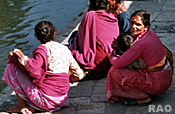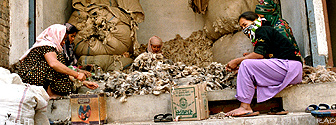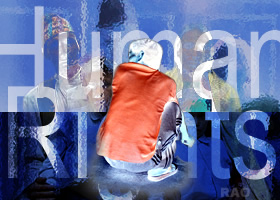 |
Nepal SOCIAL LIFE Children |
|
 |
Nepal Information |
|
|
 |
|
Child
workers face hazardous environments |
 |
KATHMANDU,
9 July 2007 (IRIN)
 |
| In
oil-stained clothes, nine-year-old mechanic Ramesh Shahi is busy changing
the wheel of a tractor with injured hands.
"I
have to support my father as he cannot make much money to support our family,"
Ramesh told IRIN in the Nepali capital, Kathmandu. |
|
The
boy works 10 hours a day at a workshop in Kathmandu for US$ 15 per month.
He
quit school after migrating with his parents from Nawalparasi District,
200km southwest of Kathmandu, to escape hardship and poverty. "But life
is more difficult here as we can't afford to buy medicines and don't have
time to go to hospital," said Ramesh.
Ramesh
is among 18,000 children working in the country's garages or similar workshops
considered to be among the most hazardous and unsafe workplaces according
to new research by a local non-governmental organisation (NGO), Concern-Nepal,
and funded by Plan International.
|
Mechanics
at risk |
 |
 |
| According
to the UN's International Labour Organisation (ILO), Nepal has 2.6 million
child labourers employed in areas categorised as hazardous. Nepal has a
total estimated population of nearly 29 million. Concern-Nepal has found
that children are e
"This
sector is considered the most exploitative in terms of child labour and
the problems are multi-dimensional," said prominent child rights activist
Bijaya Sainju of Concern-Nepal. |
|
Concern-Nepal
has recorded how young workers are forced to work in unsafe environments
- exposed to fumes, electric shocks and injuries sustained by dangerous
tools.
The
children work in garages, welding workshops, and as blacksmiths or at bicycle
repair workshops in over 4,000 centres country-wide.
"When
I got skin irritation and itching due to welding, my employer refused to
provide any medical treatment or expenses," said Hari Khadka, a 16-year-old
mechanic working in Kathmandu where he had fled to escape forced recruitment
by former Maoist rebels last year.
|
Growing
health hazards |
 |
Health
risks are growing among child mechanics. They typically suffer physical
injuries, respiratory problems and eye infections, Concern-Nepal officials
said.
Most
children are aged 14-16 and around 60 percent of them are migrants who
left their homes due to extreme poverty. Nearly 20 percent are barely 10.
When
I got skin irritation and itching due to welding, my employer refused to
provide any medical treatment or expenses.
"I
take care of myself and don't tell my employer when I get injured because
it is no use," said welder Rajendra Shah, a young worker who pours kerosene
on his wounds to treat his cuts.
But
his employer, who refused to give his name, denied he was neglecting his
workers. "So many are unemployed and we are not forcing anyone to work
with us and they can leave if they don't feel well-treated," he said.
"Child
labourers working in this sector have been mostly neglected and deprived
of support of any kind," said aid worker Prem Shukla from Plan Nepal.
|
Lack
of government action |
 |
Activists
say the government has yet to take action to safeguard child labourers.
The
country has ratified the UN Convention on the Rights of the Child and committed
itself to abide by various international conventions but not much has been
done to improve the situation of working children in Nepal, said Sainju.
Member
of Parliament Urmila Aryal said the government was considering the enforcement
of children's rights, and he welcomed pressure on this issue from NGOs,
saying it would help guide the government in developing an action plan.
 Apart
from the mechanical sector, a large number of children also work in other
areas - 60,000 in brick kilns, 72,000 in restaurants and tea shops, 32,000
in stone quarry sites and 46,000 as child porters. Apart
from the mechanical sector, a large number of children also work in other
areas - 60,000 in brick kilns, 72,000 in restaurants and tea shops, 32,000
in stone quarry sites and 46,000 as child porters.
Source: IRIN 2007
Copyright
© UN Office for the Coordination of Humanitarian Affairs 2007
[
This report does not necessarily reflect the views of the United Nations]
Integrated
Regional Information Networks (IRIN), part of the UN Office for the Coordination
of Humanitarian Affairs (OCHA). |
 |
|
Links
|
 |
 |
 |
Externe
Links |
|
related information
|
 |
|





![]() Apart
from the mechanical sector, a large number of children also work in other
areas - 60,000 in brick kilns, 72,000 in restaurants and tea shops, 32,000
in stone quarry sites and 46,000 as child porters.
Apart
from the mechanical sector, a large number of children also work in other
areas - 60,000 in brick kilns, 72,000 in restaurants and tea shops, 32,000
in stone quarry sites and 46,000 as child porters.
